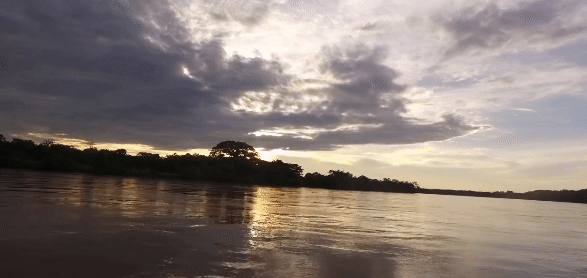The Hoover Dam near Las Vegas, Nevada, was the largest in the world when it was built in 1936. It set Lake Mead like a gem in a golden string of desert peaks along the 1,625 miles (2,300 kms) of the Colorado River, stretching from the Rocky Mountains in the United States to the Gulf of California in Mexico. Some 30 years later, Glen Canyon Dam formed Lake Powell. In the time and space between, other reservoirs came to stud the watery chain. The federal government linked them in a dazzling network to irrigate and power 20th Century western expansion. However, the jewels of growth in the United States carried a high cost for Mexico. The life they sustained north of the border was mirrored in death south of it.
 |
| Colorado River Delta: Mexican communities have mounted campaigns to save what little water trickles down to them, obtain more, and restore habitat. Photo: Archives |
Desperate, some 200,000 people in the 1,127 communities of the Colorado River”s Mexican watershed have mounted campaigns to save what little water trickles down to them, obtain more, and restore habitats. It has been an uphill battle but their efforts are starting to bear fruit. Residents have been conducting scientific monitoring for 25 years. They have nurtured wetlands, like the Cienega de Santa Clara, which is now the largest and most important marsh on the Lower Colorado and in the Sonoran Desert. They are planting endangered mesquite trees and experimenting with a new water permit scheme. They are fixing up old hunting camps to accommodate bird watchers. They have converted the Upper Gulf of California and Colorado River Delta Biosphere Reserve into a center for repopulation of unique and threatened wildlife, while using the conservation principles of the Protected Natural Area (PNA) as a motor for sustainable development. Inside the reserve, in the village of El Golfo de Santa Clara, they founded a savings and loan association for women, oriented toward protecting commercial fishing. Now they want to secure a minimum flow of Colorado River water for agriculture and other activities. They are joining together to prevent outside investment interests from unleashing development that detracts from their natural surroundings.
Unfortunately, all these initiatives could flounder. For example, if agribusiness reactivates the Yuma Desalinization Plant in Arizona, it will deny the Cienega de Santa Clara essential discharges from the Wellton-Mohawk Canal. If the All American Canal in California is hard-surfaced to increase irrigation, the concrete will deprive Mexico of 65,000 acre feet (80 million cubic meters) of seepage water annually. This means the loss of 67% of the delta”s habitat and vegetation.
Today, these and other threats are the cause of binational tussling and lawsuits, leading to worries of an impending water war. Yet solutions are possible and opportunities for collaboration are at hand. International law requires crossborder consultation on Colorado River water rights decisions. A more proactive attitude on both sides of the boundary line would have results that go beyond the requirements of the 1944 Water Treaty. Inhabitants in the Colorado”s 3.1 million acre (1.3 million hectare) area of influence in Mexico have demonstrated this already.
If the river”s dams released even 0.002 acre feet (2 cubic meters) per second more, they would provide a permanent flow to the sea. That would be enough to give a new lease on life to the habitat and the economy. The International Boundary and Water Commission acknowledged the obligation to address the water nbso online casino reviews shortage by establishing the Binational Technical Task Force in 2000. Even so, a bigger Mexican government commitment to achieving more U.S. participation in reaching conservation and restoration goals would strengthen the Delta population”s position.
Law of the River: Business First
In the United States, the 1922 Colorado River Compact allocated 90% of the river water to Imperial and Coachella valley agriculture, as well as other lands in seven states north of the border. The 1944 Water Treaty between the United States and Mexico assigned the remaining 10% (1.5 million acre feet, or 1.85 million cubic meters, a year) to Mexican growers and other businesses in the Mexicali Valley. These and related legal instruments, now known as the Law of the River, assign nothing for fishing, recreation, or wildlife, except in extraordinary cases of surplus.
 |
| Mural in Cucapa El Mayor: The powerful Colorado is an omnipotent and ever present character. Photo: Dahl McLean |
The water distribution system that kindled prosperity for people in Wyoming, Colorado, Utah, New Mexico, Arizona, and California sacrificed countless indigenous sacred sites and ancestral lands. In the Colorado River Delta of Baja California state, it robbed the Cucapah Tribe of the inheritance that gave meaning to its name: “People of the River.”
The original Colorado River Delta dwellers and their descendants traditionally have made their living farming, fishing, and with the advent of tourism, as guides for hunters attracted by migratory birds that use the water course. But in the 1970s, contamination from upstream agrochemical discharges destroyed Mexicali Valley crops. The indigenous people united with other Mexican farmers to protest at the border against U.S. policy and polluters.
Then in 1982 and 1983, inhabitants felt a wave of hope when the river showed it obeys a law of its own: During the El Niño weather cycle, the delta refilled with rainwater. But seven years ago, in October 1999, drought clutched the entire Colorado Basin. Since then, the snowmelt from the top of the Rocky Mountains has determined the amount of water left over after irrigation. This has reduced the opportunities for people already impoverished for decades in Baja California and Sonora.
Underground Dreams Emerge from the Valley
 |
Cucapah tradicional leader On
FEATURED Destacado
The world in focus: Iran in the geopolitics of the United States and IsraelBy Ariela Ruiz Caro A week after Israel launched attacks on Iranian nuclear facilities, key military infrastructure, and residential buildings—killing
June 21, 2025
 Featured
Gasoline floods the Colombian AmazonNOTE: With this excellent investigative report, we begin our collaboration with El Turbión, a website that describes itself as follows:
June 19, 2025
 Climate Change
Conflicts of Interest and Sovereignty at Stake: The Ecuador-Canada FTABy Paola Jaimes Santamaria, Pedro Labayen Herrera Last month, Ecuadorian President Daniel Noboa announced the finalization of a “free trade”
April 8, 2025
SUBSCRIBE ME TO THIS NEWSLETTERCopyright© 2023 Americas.org |
